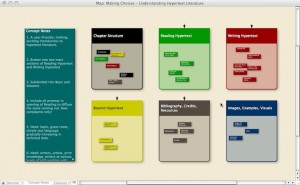HYPERTEXT PROJECT 2: Presentation
This may be a model for the presentation of this project, a book called I Live in The Future by Nick Bilton.
This may be a model for the presentation of this project, a book called I Live in The Future by Nick Bilton.
I’ve decided that with two intense hypertext projects going on, it’d be a good idea to categorize them separately so updates make more sense.
Hypertext Project 2 is going to be a sharing experience, a website and book that will offer the reading and writing of hypertext narrative in an easy and inviting manner before it becomes all academic and technical. I’ve laid out an outline for the project in Tinderbox and have just started to write down some text, though I’m sure I’ll be gleaning much of it from previous postings over the years that follow my own journey through learning.
Hypertext Project 1 is another learning experience, that of graduating to HTML5 and CSS3 (though honestly, I learned just enough of the previous versions to be able to do what I wanted to accomplish) and jQuery. So far, I’ve learned to Fade In and Out, and the Alert. But then, I jumped ahead a bit to the more interesting parts, which is typical in my learning pattern: I was once caught by the music teacher as playing a piece by ear since I couldn’t point to the spot on the page where I was supposed to be.
I’ve remarked any relative posts as such (or will within a few minutes)
Never was, I suppose, but remember, I came into this late in the game. What I’m referring to is my own personal experience with fairly simple looking hypertext narrative, or with minimal colored background and text, to its more current integration with graphics, moving visuals, and audio. This is my ultimate goal as far as creative projects are concerned, though I’m sure as a writer, I’ll be more likely to focus on or emphasize the text and keep the rest as secondary sensory titillation. I’m not impressed (though technically, I most certainly am!) with reading story that’s blasting, pulsing, fading in and out, or zipping around before you can do more than taste the words.
I’m being directed in a more interactive path. Flash media, hypermedia and towards something called Interactive Conversation Interface that I’d not heard of before. It’s a confusing trail that’s unfurling that I feel I must catch up on, even as the trails branch off like, well, hypertext.
I’ve been working in Tinderbox and Storyspace for literary purposes for a few years now. I’ve had a hypertext story published in The New River Review and my 100 Days Project of 100 Hypertext stories has been listed in the Electronic Literature Organization Directory. It’s not much, but it’s a start. Towards what goal? Well, to spread the word, to gain audience, to prove that hypertext is coming of age in a world where reading is done to a great degree online, and where hypertext literature is not only perfect for the times, it is ahead of them yet oddly it remains largely unacknowledged by both academia and the general reading population.
 What then, to do? Make it lovable. So that’s the project. Here’s the start:
What then, to do? Make it lovable. So that’s the project. Here’s the start:
From personal experience, including my own baptism into hypertext waters, and here, years later, reading the reaction of students being exposed to the medium, I’ve got to admit that the initial reaction is generally either “Yuck, I don’t see its purpose, it’s confusing” or “Wow, that’s great (but I’ll never read another one after this course is over).” So then the problem appears to be primarily in its introductory phase.
There are two problems here that I see. First, not all university courses include a new media course or even much of an inclusion in their literary courses. Secondly, since hypertext is supposedly a break from traditional reading (how is that, when links are clicked to read online so often that there’s a perceptible new “white noise” hum in the atmosphere?) it’s bound to hit resistance. Folks like ease and speed these days. Hypertext is not necessarily meant to be read fast and easy. Reading literature itself should be tough, unless we’re seeking mindless, non-demanding entertainment. And escapism for its own sake is fine; I do it all the time, only not in hypertext literature.
This is an undertaking that I’m hot on, have been for years, yet never had time to kick off. Now, I’m going to make it a part of my daily writing. It will of necessity include some team effort, people who are more skilled with the medium and have the technological know-how to produce what I clearly cannot. That’s all a part of the plan.
Then again, am I being too pushy in my attempts to be helpful? Maybe. So what?